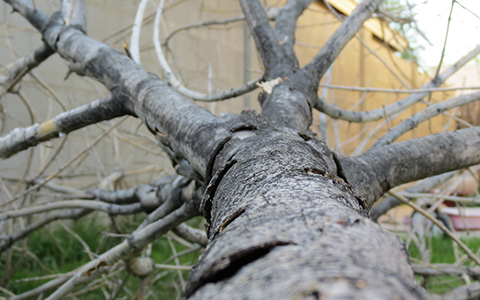
Don’t accept liability for a tree or its overhanging branches without clarifying responsibility. Once you know how to determine responsibility for a tree and its overhanging branches, you can better reach fair solutions with your neighbors during a tree dispute.
72tree.com gathered the following information on determining who owns and is responsible for a tree’s overhanging branches, and what actions to take.
Trees and Your Property Line
Whether you find yourself on the giving or receiving end of an overhanging tree complaint, it is essential to know who owns the tree in question.
When you purchased your property, you were likely required to get a property survey. If many years have elapsed or there is difficulty determining where the property line is, have a new survey conducted with the surveyor physically marking the property line.
All trees growing on your property with their trunks inside your property line are your responsibility.
In the rare case that a tree is growing directly on the property line, ownership and responsibility of that tree are equally shared between you and your neighbor.
Overhanging Tree Branches
As a tree grows upward, it also grows outward. Over time, some of those branches can grow past your property line overhanging your neighbor’s yard or home. The responsibilities of each property owner are typically as follows:

Owner of the Tree – You are responsible for the overall care of the tree, including:
• Watering, mulching, and fertilizing
• Staking or anchoring if the tree becomes unstable or is leaning
• Trimming or pruning the canopy (up to your property line)
• Detecting and treating illnesses and insect infestations. Learn more about tree health problems and solutions at 72tree.com/9-common-tree-health-problems-solutions/
If your tree succumbs to disease, infestation, or dies for any reason, the responsibility to remove the tree is yours. You could be held responsible for the damages it may cause if it should fall.
The Neighbor – Your neighbor is responsible for the following:
• The trimming or pruning of overhanging branches up to their property line*
• Cleaning fallen leaves, needles, twigs and other debris from the overhanging branches
Your neighbor should also make any concerns or complaints about potential hazards from the tree known to you.
If your neighbor documents this communication or files a complaint with the town, and you do nothing, you may be held liable for damages caused by any portion of the tree falling on your neighbor’s property.
*All trimming or pruning activities must be done in a way that promotes the health of the tree. If your neighbor’s actions result in the declining health or death of the tree, they may be held liable for the cost of the replacement of that tree.
Your Tree Falls on Your Neighbor’s Property
If your tree or a portion of the tree should fall on your neighbor’s property, the health of the tree when it fell is vital in determining responsibility.

Healthy Tree – If the tree was healthy and well maintained with no signs of decay or infestation, the removal and any damages caused by the tree will be your neighbor’s responsibility.
The majority of homeowners insurance providers will cover such a claim.
Diseased or Dying Tree – If your tree had clear signs of disease, infestation, rot, or your neighbor filed a complaint about the hazard, you could be held liable for all damages caused by the falling tree.
Protect yourself and your neighbors by hiring a trusted tree service to perform annual inspections of your trees. These inspections allow them to detect any potential trouble and recommend a course of action.
Learn more about what to do when a neighbor’s tree falls on your house at 72tree.com/my-neighbors-tree-fell-on-my-house-now-what/
View Obstruction Ordinances
Throughout the United States, there are a few cities with “view ordinances.” These ordinances state the importance of the view to the value of the property.
If your tree reaches a height that obstructs a neighbor’s view (in a city with such ordinances), you may be ordered to reduce the height of the tree or remove it.
Before planting new trees on your property, it is worth the time and effort to research your city’s laws for these specific ordinances. Once you know the limitations imposed by these ordinances, you can select the appropriate species to plant.
Overhanging Tree Responsibility
In this article, you discovered how tree ownership is determined, what you are responsible for when trees overhang a neighbor’s property, and their responsibilities.
By properly caring for your trees and having them inspected annually, you can detect potential issues early and get them resolved before turning into a problem or dispute.
If you choose to neglect the health of your tree(s), you can be held liable for all damages caused by that tree falling on your neighbor’s property or house.
NOTE: Cities, municipalities, and towns have ordinances that may vary from the information presented in this article. It is always recommended that you search for your city’s tree ordinances to fully inform yourself.
Sources:
http://agrisk.umd.edu/blog/frequently-asked-questions-can-i-cut-my-neighbors-tree-back-from-our-property-line
hg.org/legal-articles/neighbor-s-right-to-build-36677
extension.tennessee.edu/publications/Documents/SP687.pdf
secure.caes.uga.edu/extension/publications/files/pdf/C%201099_1.PDF
No comments:
Post a Comment
Note: Only a member of this blog may post a comment.